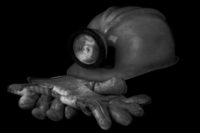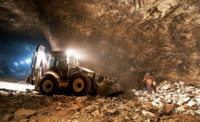Controversial new coal dust reg goes into effect today
Mining industry says MSHA ignored its input
|
Provisions of the first phase:
|
New respirable dust regulations that are intended to reduce the incidence of black lung disease among miners take effect today, over the objections of the National Mining Association (NMA), which calls them “one-size-fits-all approach” that won’t deliver real worker protections.
“Lowering Miners’ Exposure to Respirable Coal Mine Dust, Including Continuous Personal Dust Monitors,” which was released on May 1 by the Mining Safety and Health Administration (MSHA), will be phased in over the next two years at all surface and underground coal mining operations. The first phase of the rule continues the department’s efforts through its End Black Lung – Act Now! initiative.
The MSHA says this first phase provides immediate protections to miners and contains critical provisions that eliminate loopholes that have masked overexposures to coal dust.
76,000 fatalities since 1968
Prolonged exposure to respirable coal mine dust causes lung diseases such as coal workers’ pneumoconiosis, emphysema and progressive massive fibrosis. These diseases, collectively referred to as black lung, can lead to permanent disability and death. According to the National Institute for Occupational Safety and Health, more than 76,000 miners have died since 1968 as the result of the disease, and more than $45 billion in federal compensation benefits have been paid to coal miners disabled by black lung and their survivors.
Evidence indicates that miners, including young miners, continue to be diagnosed with the disease. The investigation of the 2010 Upper Big Branch mine disaster disclosed that 17 of the 25 miners who died had evidence of black lung. Just last month, the department’s Office of Workers’ Compensation Programs announced that it expects more than 7,400 claims to be filed this year as a result of the disease.
NMA wanted "practical measures"
NMA President and CEO Hal Quinn said the MSHA ignored his organization’s “numerous, straight-forward recommendations for practical measures” to reduce respirable dust.
MSHA chief Joseph A. Main said that the recent impact inspection at Rhino Eastern LLC’s Eagle Mine 3, where inspectors found virtually no dust controls, underscores the need for the rule.
The final rule lowers miners’ exposure to coal dust, substantially increases operator sampling for respirable coal mine dust, and requires immediate corrective action when an operator’s sample shows excessive concentrations. While the frequency of sampling by MSHA inspectors does not change, the final rule authorizes MSHA to cite an operator based on a single MSHA sample showing excessive dust, rather than on an average of samples.
Real-time measurements an issue
Watzman said the requirement that operators take immediate corrective actions is based on sampling technologies that he says do not provide them with real-time measurements.
“Sampling data on which ‘immediate actions’ must be based will only be available days or weeks later, therefore having no relevance to actual dust levels at the time data is received,” he said. “The technology needed to comply with this provision will not be available until at least 18 months later.”
The agency’s web page contains compliance material, fact sheets, frequently asked questions and answers, dust sampling certification guides and other information.
The next phase of implementation of the final rule goes into effect on Feb. 1, 2016.
Looking for a reprint of this article?
From high-res PDFs to custom plaques, order your copy today!








